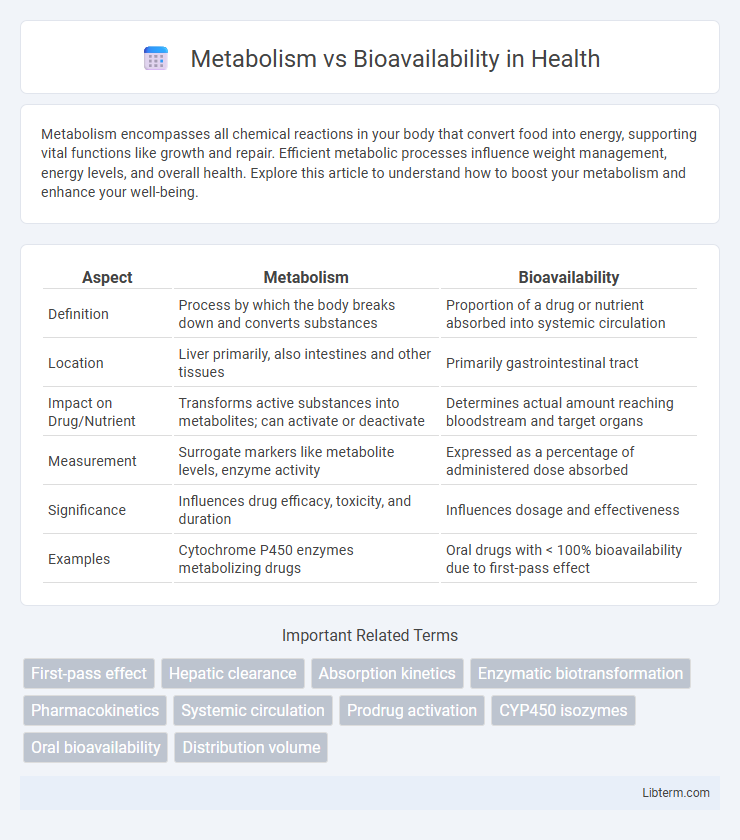Metabolism encompasses all chemical reactions in your body that convert food into energy, supporting vital functions like growth and repair. Efficient metabolic processes influence weight management, energy levels, and overall health. Explore this article to understand how to boost your metabolism and enhance your well-being.
Table of Comparison
| Aspect | Metabolism | Bioavailability |
|---|---|---|
| Definition | Process by which the body breaks down and converts substances | Proportion of a drug or nutrient absorbed into systemic circulation |
| Location | Liver primarily, also intestines and other tissues | Primarily gastrointestinal tract |
| Impact on Drug/Nutrient | Transforms active substances into metabolites; can activate or deactivate | Determines actual amount reaching bloodstream and target organs |
| Measurement | Surrogate markers like metabolite levels, enzyme activity | Expressed as a percentage of administered dose absorbed |
| Significance | Influences drug efficacy, toxicity, and duration | Influences dosage and effectiveness |
| Examples | Cytochrome P450 enzymes metabolizing drugs | Oral drugs with < 100% bioavailability due to first-pass effect |
Understanding Metabolism: Key Concepts
Metabolism involves the biochemical processes that transform drugs into metabolites, primarily occurring in the liver via enzymes such as cytochrome P450. These metabolic reactions, including phase I oxidation and phase II conjugation, can alter the drug's chemical structure, affecting its pharmacological activity and elimination. Understanding metabolic pathways is essential for predicting drug bioavailability, as extensive first-pass metabolism can significantly reduce the active drug concentration reaching systemic circulation.
What is Bioavailability? An Overview
Bioavailability refers to the proportion of a drug or nutrient that enters the systemic circulation and is available for therapeutic or physiological effect after administration. It is a critical pharmacokinetic parameter influencing the efficacy of orally administered drugs, as it determines the extent and rate at which the active substance reaches the bloodstream. Factors such as drug formulation, gastrointestinal absorption, metabolism, and first-pass hepatic clearance critically impact bioavailability, differentiating it from metabolism, which is the biochemical modification of substances within the body.
Metabolism vs Bioavailability: Core Differences
Metabolism refers to the biochemical processes that transform drugs within the body, primarily in the liver, affecting their active form and duration. Bioavailability measures the proportion of a drug that reaches systemic circulation intact, influencing its therapeutic effectiveness. Understanding the core differences between metabolism and bioavailability is crucial for optimizing drug dosing and efficacy in pharmacokinetics.
How Metabolism Impacts Nutrient Absorption
Metabolism significantly affects nutrient absorption by transforming ingested compounds into bioavailable forms that the body can utilize effectively. Enzymatic processes in the liver and intestines modify nutrients, which influences their bioavailability by either enhancing or reducing their absorption into the bloodstream. Variations in metabolic rate and enzyme activity can lead to differences in how efficiently nutrients like vitamins, minerals, and drugs are absorbed and used by the body.
Factors Influencing Bioavailability
Bioavailability is primarily influenced by factors such as the drug's physicochemical properties, formulation, and route of administration, which determine the extent and rate at which the active substance reaches systemic circulation. Metabolism plays a crucial role by affecting the drug's first-pass effect, where enzymes in the liver and intestinal wall metabolize the compound before it reaches systemic circulation, reducing bioavailability. Patient-specific factors including age, genetics, gastrointestinal pH, and concurrent medications also impact the metabolism and thus the bioavailability of a drug.
The Role of Enzymes in Metabolism
Enzymes such as cytochrome P450 play a critical role in drug metabolism by catalyzing biochemical reactions that transform lipophilic compounds into more hydrophilic metabolites, facilitating excretion and reducing bioavailability. Phase I enzymes introduce functional groups through oxidation, reduction, or hydrolysis, whereas Phase II enzymes conjugate these metabolites with polar molecules, enhancing solubility. The efficiency and presence of these metabolic enzymes directly influence the concentration of active drug available for therapeutic effect in systemic circulation.
Bioavailability in Drugs and Supplements
Bioavailability in drugs and supplements refers to the proportion of an active substance that enters the bloodstream and is available for therapeutic effect after administration. Factors such as formulation, gastrointestinal absorption, first-pass metabolism, and chemical stability significantly influence bioavailability. Optimizing bioavailability is essential to ensure efficacy, as low bioavailability can reduce a drug's therapeutic impact despite high metabolic stability.
Interplay Between Metabolism and Bioavailability
The interplay between metabolism and bioavailability fundamentally affects drug efficacy by determining the extent and rate at which an active pharmaceutical ingredient reaches systemic circulation. Metabolic processes, primarily occurring in the liver via enzymes such as cytochrome P450, can significantly reduce bioavailability by transforming drugs into inactive metabolites before they reach their target sites. Understanding this relationship is essential for optimizing drug formulation and dosing regimens to achieve desired therapeutic outcomes.
Practical Ways to Improve Bioavailability
Enhancing bioavailability involves optimizing factors such as drug formulation, absorption, and metabolism to maximize therapeutic efficacy. Techniques like utilizing lipid-based drug delivery systems, employing enzyme inhibitors to reduce first-pass metabolism, and improving solubility through nanoparticle technology significantly increase a drug's systemic availability. Understanding the interplay between metabolic processes and absorption pathways is crucial for developing effective strategies that improve bioavailability in clinical applications.
Metabolism, Bioavailability, and Health Outcomes
Metabolism determines how drugs are chemically transformed by enzymes, influencing their active form and duration within the body, directly affecting bioavailability, which is the proportion of a drug that reaches systemic circulation intact. High metabolism rates can reduce bioavailability, potentially diminishing therapeutic effectiveness and altering health outcomes by requiring dosage adjustments to achieve desired plasma concentrations. Understanding the interplay between metabolism enzymes like CYP450 and drug bioavailability is crucial for optimizing treatment efficacy and minimizing adverse effects.
Metabolism Infographic

 libterm.com
libterm.com